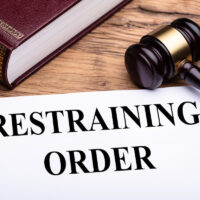How Long Does a Restraining Order Last in California?

A restraining order is a court order issued upon application by one party that forbids another party from engaging in certain activities. A typical restraining order stemming from an allegation of domestic violence, for example, may prohibit one party (the target) from engaging in any violent or harassing conduct toward another party (the alleged victim) and prohibit the target from approaching the victim or the victim’s home, workplace, or family. There are several types of restraining orders in California with differing longevity. Read on for an explanation of the duration of restraining orders, and reach out to a knowledgeable Ventura criminal defense attorney with any questions.
Types of Restraining Orders
In California, there are a few types of restraining orders that are intended to last varying amounts of time. The main types of restraining orders in California are Emergency Protective Order (EPO), Temporary Restraining Order (TRO), and Domestic Violence Restraining Order (DVRO).
Law enforcement officers may seek an Emergency Protective Order if they believe that a victim is in immediate danger of physical harm. Law enforcement may contact a judge and seek an EPO, for example, after responding to a report of domestic violence; these orders go into effect immediately. The court can issue an EPO without having the alleged abuser or the victim step in a courtroom. An EPO is meant to be temporary and can last a maximum of five business days or seven calendar days.
If the EPO is set to expire before a final DVRO hearing can be held, then the alleged victim can seek a Temporary Restraining Order against the alleged aggressor at an “ex parte hearing.” Ex parte means that the hearing can be held without the target of the TRO present. The victim again is seeking immediate court intervention for urgent matters, such as the continuing and immediate threat of physical violence against the victim or their family. A TRO can last up to 15 days or until the court holds a full DVRO hearing, which is usually a maximum of three weeks.
After a hearing, the court may choose to issue a full Domestic Violence Restraining Order. To issue a DVRO, the court must hold a hearing and allow the alleged aggressor to present their side of the matter. The initial DVRO can last up to five years. A DVRO is intended to prevent an alleged abuser from threatening, harassing, or abusing a victim. At the end of the five-year period, the victim can ask the court to extend the DVRO for another five years or even ask that the DVRO be extended indefinitely. The alleged victim must show the court that they have a reasonable fear that the abuser will threaten, harass, or abuse them should the DVRO be allowed to expire.
Defend Against a Restraining Order or Criminal Charges in Oxnard and Ventura County
If you are made the target of an unjustified restraining order, or you are facing criminal charges in southern California, get knowledgeable, compassionate, and effective legal help by contacting the Ventura offices of Paul Tyler for a free consultation at 805-889-9000.
